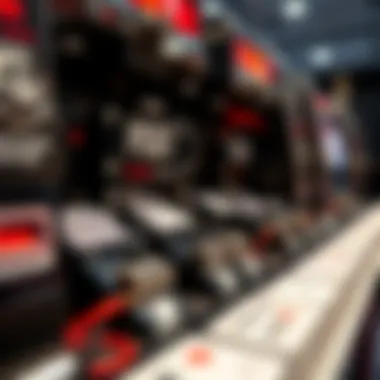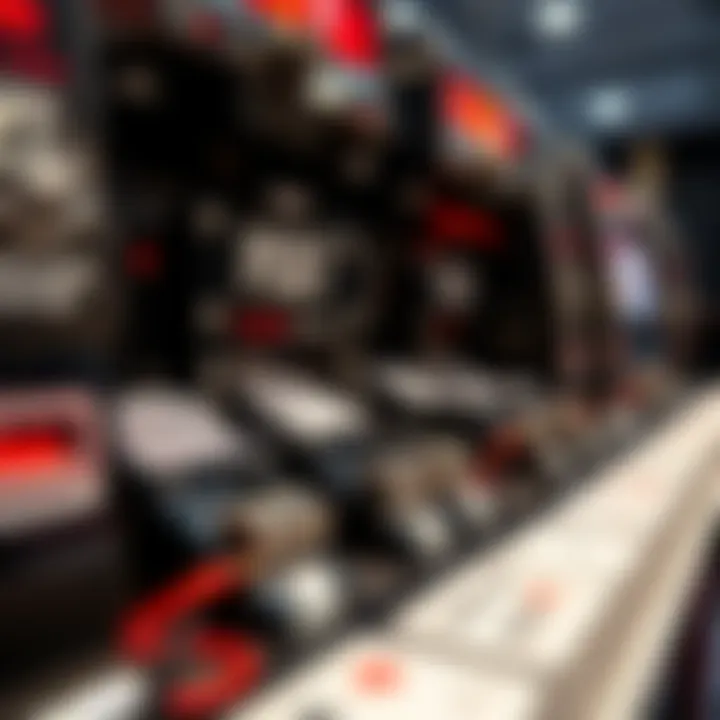Exploring Automatic Card Shuffling Machines and Their Impact


Intro
In a world where the shuffle of cards can dictate fortunes, automatic card shuffling machines have emerged as a pivotal influence in the betting and gaming industry. Their introduction marks a significant transformation in how games are played and enjoyed, enhancing both the integrity and pace of play. Gone are the days when human fingers mastered this essential task, leaving it now to machines designed for precision and speed.
These devices, crafted with meticulous engineering, not only shuffle cards but also elevate the gaming experience in ways that might not be immediately apparent. From casinos glittering under bright lights to home game nights where friends gather around the table, the impact of these machines extends across a vast array of settings. In doing so, they slyly merge technology with tradition, forging a path that both seasoned gamblers and novices traverse with eagerness.
But, what does this mean for players? Both casual and professional gamblers stand to gain from understanding these systems. By shedding light on the mechanics of automatic card shuffling machines, this article aims to equip you with knowledge that can inform your strategy and enhance your gaming experience. As we journey through their functionality, significance, and advancements, prepare to deepen your appreciation for what these machines bring to the table—literally and metaphorically.
Let's begin by diving into the strategies that govern the betting universe.
Prologue to Automatic Card Shuffling Machines
In an age where technology permeates every facet of our lives, the card gaming industry has not remained untouched. Automatic card shuffling machines emerge as a significant innovation in this realm. These machines not only streamline the card shuffling process but also enhance the overall gaming experience—seamlessness becomes the name of the game. The introduction of these devices fundamentally changes the dynamics of card games, pushing past conventional manual shuffling into the realm of efficiency and reliability.
Definition and Overview
Automatic card shuffling machines are devices designed to shuffle decks of playing cards mechanically, largely reducing or entirely eliminating the need for manual shuffling. They are crafted with various forms of technology and mechanics that ensure thorough mixing of cards while saving valuable time during gameplay. In casinos, where the stakes are high, and the pace is fast, automatic shuffling becomes not just a convenience but a necessity. From traditional games like poker and blackjack to newer variations, these machines help maintain the flow of gameplay while ensuring fairness in dealing.
One might find that these machines are not just limited to professional settings; they are also becoming popular among casual players who want to elevate their home game nights, making the act of shuffling less of a chore and more of a seamless transition into the game.
Historical Context
The journey of card shuffling machines can be traced back several decades. Initially, shuffling was an entirely manual task, often seen as a small but crucial part of card games. Early devices were rudimentary, designed primarily to assist in shuffling rather than replace the human touch.
As gaming environments evolved, especially during the mid-20th century, so did the technology behind these machines. The first successful automatic shuffling machines made their debut in the 1970s in Las Vegas and other bustling casino hubs. These early models, while basic by today’s standards, set the stage for future innovations.
As demand increased, manufacturers responded with innovations, embedding more sophisticated mechanics and electronic components into their design. Brands like Shuffle Master and others revolutionized the market, leading to today's advanced models that not only shuffle cards but can even track deck composition and enhance game integrity. These advancements reflect a significant shift in the gaming landscape, where technology is not merely an accessory but a central element.
"The history of automatic card shuffling machines is a testament to the blending of tradition and innovation—where classic games meet modern efficiency."
Design and Functionality
The design and functionality of automatic card shuffling machines play a pivotal role in the modern gaming landscape. These machines are not just tools; they are integral to the flow of card games, ensuring that every shuffle is efficient, random, and secure. By delving into how these machines are crafted and operate, we can better appreciate their significance in enhancing the overall gaming experience.
Mechanics of Card Shuffling
Understanding the mechanics of card shuffling unveils the intricacies behind automatic shuffling machines. Essentially, these machines utilize a series of gears, belts, and motors to manipulate decks of cards. When a player inputs a deck, the machine can accomplish multiple shuffles in a matter of seconds, far outpacing manual methods.
The basic idea is not just to mix cards but to do so in a way that minimizes patterns, ensuring random distribution. Many machines simulate manual shuffling techniques, incorporating riffle, overhand, and strip shuffles to mimic real-life actions. In addition to technical prowess, certain machines even incorporate sensors to detect if a card is jammed or misaligned, which showcases the sophistication of modern design.
"The heart of the shuffle is not merely the act itself, but the technology that makes it precise and rapid."
Key Components
The efficacy of these machines can be attributed to their key components. Each part serves a unique function and is crucial for the overall performance.
- Feeder Slots: These are designed to hold decks securely while they are being shuffled. Their design can vary, but they typically allow cards to slide in without damage.
- Shuffling Mechanism: This can range from simple rotating gears to more complex systems that mimic human hands. It's vital for randomization, ensuring no two shuffles yield the same order.
- Control Systems: Most machines use integrated circuits to manage the shuffling process. These systems can be programmed to alter shuffling techniques based on user preference or game type.
- Power Supply: These machines generally require electrical power, which permits faster and more consistent shuffling compared to hand-based methods.
Each component must work in harmony. Attention to detail in design allows these machines to function at optimal levels, providing smooth and effective shuffling that players can rely on.


Types of Shuffling Techniques
Automatic shuffling machines employ a variety of shuffling techniques that contribute to their effectiveness, mirroring the intuitive methods used in manual shuffling.
- Riffle Shuffle: This is perhaps the most recognizable technique, where cards are split into two halves and interwoven. Many machines replicate this by using a series of conveyor belts and rollers to achieve that familiar randomization effect.
- Overhand Shuffle: Although less common in machines, some devices can perform an overhand style shuffle by grabbing chunks of cards and mixing them together. This highly effective technique is retained for its simplicity.
- Strip Shuffle: This technique involves moving blocks of cards back and forth to ensure thorough mixing without relying on complex algorithms. Some machines offer this as an option for players who prefer a more tactile experience.
- Cyclic Shuffle: In certain advanced machines, a cyclic shuffle can be programmed to ensure a specific level of randomization dictated by game requirements or player preference.
The versatility of these shuffling techniques not only enhances efficiency but also caters to different gaming needs. This freedom of choice is essential in accommodating various player styles and enhancing their overall experience.
Advantages of Automatic Shuffling
The advent of automatic card shuffling machines has changed the landscape of gaming significantly. As more players seek a streamlined and efficient gaming experience, understanding the advantages of automatic shuffling is essential. It not only encompasses convenience but also elevates the overall quality of gameplay. Each of these offerings plays a crucial role in redefining how games are played and experienced, particularly for gamblers and poker enthusiasts. Let’s delve into the key elements that underline these advantages.
Efficiency in Gameplay
When speed becomes paramount, automatic shuffling machines shine brighter than a coin at the gambling table. Players often crave an uninterrupted flow to their games, and manual shuffling can be a bottleneck. With a flick of a switch, an automatic machine can shuffle multiple decks in a fraction of the time it takes a dealer. The time saved for each reshuffle accumulates across sessions, allowing players more opportunities to partake in hands during their time at the table. This efficient gameplay is particularly salient in high-stakes environments where every second counts.
- Less Downtime: Automatic shuffling reduces the idle time, keeping the energy of the game alive.
- Quick Setup for Multiple Games: For casinos orchestrating various table games, rapid shuffling allows for quick team transitions.
- Focused Experience: Players can concentrate on strategies and decisions rather than the mundanity of shuffling.
Enhanced Randomization
Another critical advantage lies in the enhanced randomization provided by these machines. The way cards are mixed in a manual shuffle can be predictable, influenced by the dealer's technique. An automatic shuffling machine employs various advanced algorithms designed to ensure comprehensive randomness. As a consequence, each hand is less susceptible to patterns, creating a more unpredictable and thrilling gaming experience.
"In games of chance, randomness is the secret sauce that keeps players coming back. Without it, the thrill fades away."
- Algorithms at Work: Many machines utilize cutting-edge programming to simulate several shuffling techniques, breaking traditional boundaries of randomness.
- Unbiased Play: Players can rest assured knowing that every shuffle is impartial, independent of human influence.
Reduction of Human Error
Human error is simply a part of life, but when it comes to card games, it can lead to significant discrepancies. Manual shuffling may introduce biases, such as clumping of ranks or suits, which can adversely affect the outcome of the game. Automatic machines, however, eliminate these variables effectively, offering consistency that players can rely on. This consistent performance enforces fairness across games, building trust between players and operators.
- Uniform Shuffles: Machines produce the same quality of shuffle every time, regardless of operator fatigue.
- Minimized Disputes: Automatic shuffling lessens the occurrence of disputes over shuffle quality, streamlining the gameplay further.
Applications in the Gaming Industry
The significance of automatic card shuffling machines in the gaming industry cannot be overstated. These devices streamline the gameplay experience, providing several benefits that enhance the overall efficiency and enjoyment for both casual and professional players. Their applications span across various settings, each bringing its own set of advantages and considerations.
Casino Environments
In casinos, where the stakes can be high and the pace frantic, automatic shuffling machines have become a staple. They offer several key benefits:
- Speed: The time taken to shuffle cards manually can slow down the game significantly, impacting revenue and customer satisfaction. Automatic shufflers can mix multiple decks quickly, allowing casinos to maximize gameplay times.
- Consistency: Players expect a level playing field. With automatic machines, the randomness of shuffles is more reliable than human shuffling, thereby ensuring fair play. This is crucial in maintaining trust between the house and patrons.
- Reduced Staffing Costs: If shuffling is automated, dealers can focus on interaction and monitoring the game, which can enhance the customer experience. Staff resources can be better allocated for other aspects of the casino operation.
While the advantages are compelling, there are some considerations:
- Casinos must invest in reliable equipment, as frequent breakdowns can lead to operational disturbances.
- Some traditional players might view these innovations skeptically, raising questions about the authenticity of the gaming experience.
Online Gaming Platforms


As the online gaming industry grows, automatic card shuffling machines have found their way into virtual spaces as well. Their applications in this arena include:
- Streamlined Operations: Online platforms utilize sophisticated algorithms for shuffling cards digitally, which can ensure not only speed but also an elaborate level of randomization, competing efficiently for users’ attention.
- Player Trust: By employing automatic shuffling algorithms, online casinos can assure players that the outcomes are fair. This trust is essential; players want to know the system isn’t rigged.
- Enhanced User Experience: Faster game rounds improve engagement levels. In online settings, where attention spans may wane, delivering quick and fair games is critical.
Despite these benefits, there are challenges:
- Heavy reliance on technology poses risks; internet outages or server errors can lead to disruptions, frustrating users and possibly creating losses.
- Players might not always understand the technology behind shuffling and could be wary of its transparency.
Home Use and Poker Nights
For enthusiasts enjoying games at home or during friendly poker nights, automatic card shuffling machines add a level of convenience that is hard to ignore:
- Ease of Use: Many of these machines are compact and user-friendly, making it easy for casual gamers to integrate them into their gatherings. Players don’t need to worry about shuffling cards effectively while maintaining conversation and camaraderie.
- Time-Saving: No one likes to wait an eternity for the cards to be shuffled. These machines allow for quick transitions between hands, keeping the game lively.
- Inclusivity: For players who might struggle with manual dexterity, automatic shufflers make games accessible for everyone. It enhances participation amongst a broader audience, making the social aspect of game nights more enjoyable.
However, there are points to consider:
- Investing in a shuffler can be an extra expense that some might not want to add, especially for casual players.
- For traditionalists, the charm of manually shuffling cards, with all its nuances and rituals, may feel lost.
"In a world where quick access and convenience reign supreme, automatic card shuffling machines have etched a permanent mark upon the landscape of gaming across various platforms."
In essence, the applications of automatic card shuffling machines in the gaming industry are diverse and profound. From enhancing customer satisfaction in clubs and casinos to ensuring fair play in online environments, these machines are changing the game – literally. For home users, they blend ease and enjoyment, making the often-fluid world of card games more approachable for many. Understanding and appreciating these applications is vital for anyone interested in the evolving dynamics of the gaming landscape.
Technological Advancements
The gaming industry is often seen as a lively melting pot of tradition and innovation, and automatic card shuffling machines stand testament to that duality. As we explore the realm of technological advancements, it’s clear these machines play a pivotal role in reshaping how games are played, from casual poker nights to high-stakes casino tournaments. Today, these devices aren't just a novelty; they embed intelligent systems that bolster efficiency, enhance player experience, and minimize the risks associated with human error.
Smart Technology Integration
A significant leap in the operation of automatic shuffling machines is the integration of smart technology. In today’s digitally driven world, card shuffling has adopted features that echo common smart devices. Modern shuffling machines often come equipped with sensors that monitor the condition and number of cards being shuffled.
To delve deeper, consider the following aspects of smart technology integration:
- Card Detection: Utilizing RFID technology, some machines can identify cards and verify that they are the appropriate type for the game being played. This virtually eliminates mistakes arising from using the wrong set of cards.
- Real-Time Feedback: These smart machines can provide feedback to operators, alerting them to any mishaps during the shuffling process. Imagine a scenario where the machine recognizes a malfunction and sends notifications to the staff, allowing for rapid intervention.
- Remote Monitoring: Operators can oversee machine performance remotely, which enhances the operational reliability of gaming establishments. This integration is akin to having a personal assistant dedicated to ensuring everything runs like clockwork.
The incorporation of smart technology into automatic shuffling machines doesn't just streamline operations; it also enhances the players' trust in the game's integrity. The more transparent the process, the greater the confidence players have in the fairness of the game.
Future Innovations
Looking ahead, the scope for future innovations in card shuffling technology seems quite promising. With advancements in artificial intelligence and machine learning, the potential to elevate card shuffling systems is nearly limitless. Envision buildings equipped with adaptive machines that learn the shuffling preferences of different games and players over time.
Here are some intriguing prospects for innovation:
- Advanced Algorithms: Future machines might use sophisticated algorithms to genuinely mimic the randomness of a deck shuffled by hand, potentially increasing unpredictability in card distribution.
- Interactive Features: Imagine a shuffling machine that not only shuffles but also interacts with players, perhaps showing visual cues or providing information on the next game phase through a user-friendly interface.
- Increased Versatility: Innovations may lead to machines capable of handling various formats, from the traditional poker deck to unique sets used in emerging games. The adaptability of these machines could cater to evolving gaming trends, keeping establishments at the cutting edge.
In sum, the landscape of automatic card shuffling is on the cliff of rapid transformation. As technological advancements take root, they not only enhance the operational facets of gaming businesses but foster new ways for engagement within the gaming community.
"In the world of gaming, staying ahead means embracing change, and the future of automatic shuffling machines is a fine example of innovation shaping the experience for everyone involved."


With these developments, the gaming industry can expect its card-shuffling processes to become more efficient, fair, and engaging. As we stand at this intersection of technology and tradition, the players, operators, and enthusiastic observers can look forward to what’s coming next.
Critiques and Limitations
When discussing automatic card shuffling machines, it is essential to delve into the critiques and limitations surrounding their use. Although these devices bring numerous advantages to the gaming arena, they are not without their own set of drawbacks and criticisms. Analyzing these factors offers insight into the broader implications of incorporating such technology into traditional card games.
Operational Limitations
One of the primary concerns regarding automatic card shuffling machines lies in their operational limitations. Not every model is created equally; some machines may struggle with specific types of cards, especially those that are thick or worn out. For instance, a machine designed for standard poker decks may not handle high-quality, textured cards typically used in bridge. Additionally, the speed of shuffling can vary widely. While some machines perform efficiently and quickly, others may take longer than the time it takes for a human to accomplish the same task, particularly with more complex shuffling patterns. A shuffle that fails to provide genuine randomness can alter the gameplay – turning what should be a fair game into a predictable outcome.
Cost Implications
Cost is another critical element to consider when evaluating automatic shuffling machines. Acquiring a high-quality machine can represent a hefty investment for casinos and game aficionados alike. While labor costs may decrease over time by automating the shuffling process, the initial expenses can still be prohibitive. Moreover, maintenance and repair costs can add to the financial burden in the long run. Cheap models might seem attractive at first glance, yet they risk frequent breakdowns or subpar performance—ultimately costing more in the big picture. Prospective buyers must weigh these financial considerations against the potential benefits to determine if a card shuffling machine aligns with their budget and gaming needs.
Resistance from Traditionalists
Lastly, there's the resistance from traditionalists who prefer the tactile experience of manual shuffling. Many seasoned gamblers argue that human interaction adds an element of excitement and authenticity to the game. They hold firm to the notion that the act of shuffling cards by hand establishes a deeper connection to the game itself. This sentiment is particularly strong among poker players, where the psychological aspect of gameplay can be as vital as strategy. For traditionalists, the idea of relying on machines can feel impersonal or detract from what they perceive as the spirit of the game.
As these perspectives demonstrate, it is crucial for enthusiasts, gamblers, and stakeholders alike to recognize the critiques and limitations associated with automatic card shuffling machines. By doing so, they can better engage in discussions about how best to integrate technology into the world of gaming, ensuring that it enhances the experience without overshadowing its fundamental nature.
The Future of Card Shuffling Machines
As technology persists in reshaping all facets of life, the world of card games is no exception. The future of card shuffling machines holds much promise, not merely in enhancing gameplay but also in revolutionizing the way players perceive fairness, speed, and accessibility in card games. With automatic shuffling growing ever more popular, understanding the future trends is crucial for both players and industry professionals.
Trends in Usage
The trajectory of automatic card shuffling machines seems to pivot on several emerging trends that are reshaping their usage across various platforms. One noteworthy shift is the increase in demand for these devices in online gaming environments. As remote gaming continues its meteoric rise, the need for verified randomness and fairness has become paramount, with players increasingly favoring shuffling machines that guarantee transparent and unbiased shuffling processes. This has prompted developers to create more sophisticated models that can seamlessly integrate into online platforms, while maintaining compliance with gaming regulations.
- Casual and Competitive Play: From intimate home games to larger tournaments, the adaptability of these machines makes them a valuable asset. Players are gravitating towards machines that enhance not only the experience but also the seriousness of home gatherings.
- Multi-game Versatility: Card shuffling machines are no longer confined to poker alone. Variants of games like blackjack, bridge, and others have begun incorporating these devices, enriching gameplay and expanding market potential.
- Increased Connectivity: Wi-Fi-enabled machines will connect to smartphones or tablets, allowing players to monitor gameplay and statistics in real-time. This digital adaptation transforms traditional gaming rooms into data-rich environments.
Impact on Game Design
The future of card shuffling machines isn't merely a matter of efficiency; it's also about the way these devices influence game design. Designers now face an array of possibilities that stem from the capabilities of automatic shuffling. In many ways, the machines are not just tools; they are integral to the evolving landscape of gaming.
- Algorithmic Shuffling: These machines utilize complex algorithms to enhance randomness, thus pushing game designers to adjust their strategies accordingly. The reliance on software to dictate card distribution can lead to more strategic depth, fundamentally altering the way games are played.
- Dynamic Game Structures: As shuffling machines become more advanced, expect a rise in the development of dynamic game structures that require frequent reshuffling. This aims to maintain player engagement and eliminate predictability, thereby enhancing the sensory experience of the game.
- Enhanced User Experience: The integration of automatic shuffling allows for smoother transitions and quicker gameplay. In fast-paced environments like casinos, this results in improved turnover rates, directly impacting profitability for establishments.
As the landscape of card games shifts, one can expect automatic shuffling machines to remain at the forefront, driving innovations that were once thought to be the realm of visions.
Epilogue
The exploration of automatic card shuffling machines allows us to appreciate their vital role within the gambling landscape. These devices encapsulate a blend of efficiency and innovation, elevating not only gameplay but also the fairness that players rightfully expect in their gaming experience. In considering this article, several critical points emerge that warrant emphasis.
Summarizing Key Points
- Efficiency Gains: Automatic shuffling machines expedite the shuffling process, reducing wait times and maximizing gameplay flow. Players and dealers alike benefit from the faster pace of card distribution.
- Enhanced Randomization: These machines employ sophisticated algorithms that enhance the randomness of card distribution, ensuring a fairer game environment that minimizes predictability.
- Reduction of Human Error: By mechanizing the shuffling process, the possibility of human error is significantly diminished. This aspect is particularly pivotal in casino settings where stakes are high, and precision is of utmost importance.
- Wider Applications: Beyond traditional casinos, these machines have found their utility in online gaming platforms and home poker setups, reflecting their versatility in a variety of gaming environments.
- Technological Innovations: Continuous advancements, such as smart technology integration, persistently push the envelope for what these machines can offer, curling expectations for future designs.
Consider this: The advent of automatic shuffling machines is a testament to the industry's evolution, displaying how technology can enhance an age-old pastime with precision and reliability.
Final Thoughts on Technology in Gaming
In summation, the trajectory of card shuffling machines heralds a pivotal shift in how card games are approached, played, and enjoyed. For gamblers, these machines not only streamline the gaming experience but also reinforce notions of fairness and reliability that are foundational to the gaming industry.
The implications for game design are noteworthy; developers have to rethink how they construct gameplay dynamics in environments where shuffling machines become a norm. Furthermore, the fusion of technology and traditional gaming might lead to new formats that blend familiarity with engaging innovations.
As we consider the future, it's clear that automatic card shuffling machines symbolize a broader trend towards technological integration in all facets of life. As players become increasingly sophisticated and demanding, the industry must adapt and innovate to meet these rising expectations.







